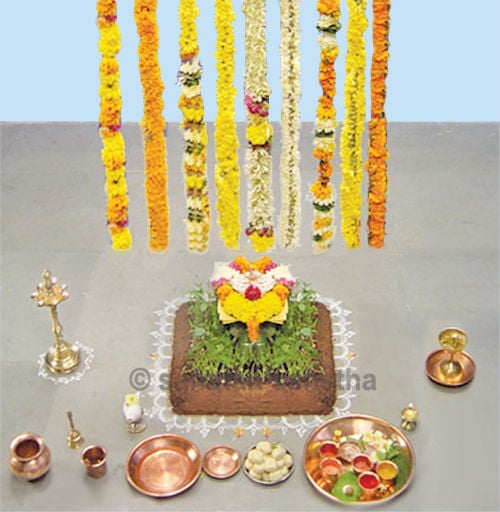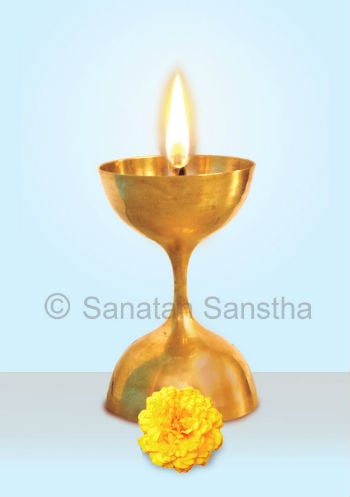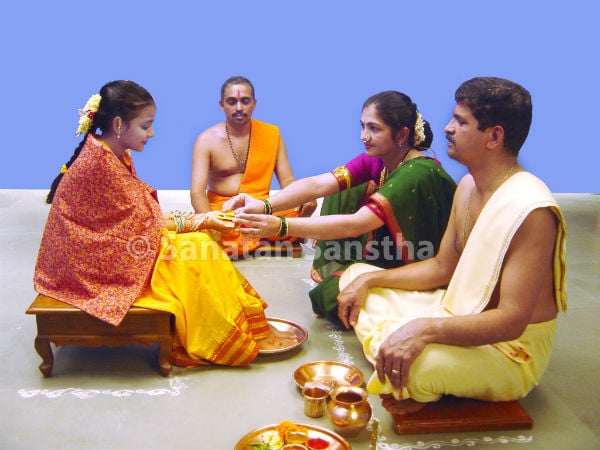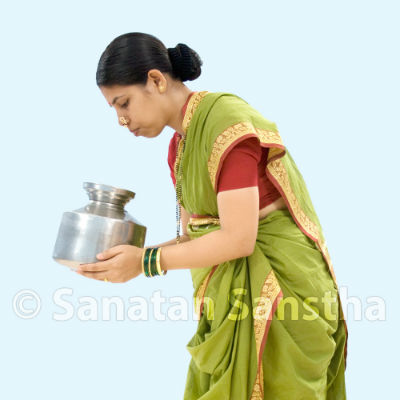Contents
- 1. History of Navratri
- 2. Importance of Navratri
- 3. Method of performing the vrat during Navratri
- 4. Performing the Lalita Pujan on the fifth day of Navratri
- 5. Worshipping an idol of Goddess in standing posture on the eighth day of Navratri
- 6. Worship of Goddess Saraswati on the eighth and ninth day of Navratri
- 7. Ritual of Ghagar Phunkane performed on eighth day of Navratri
- 8. Playing Bhondala during Navratri
Sarva mangala mangalye shive sarvartha sadhike |
Sharanye trayambake gauri, Narayani namostute ||
Meaning: O Mother ! You are the personification of all that is auspicious, You are the benevolent form of Lord Shiva, You bestow Divine energy and help people achieve Righteousness, wealth, fulfill desires and Liberation, You are worthy of being surrendered to. Three eyes adorn You. O Narayani Devi, I pay obeisance to You !
Navratri is a widely celebrated festival by Hindus across the world. This nine-day festival is celebrated by worshipping Shakti (Divine Energy). The festival of Navratri commences on the first day (Pratipada) of the bright fortnight of the Hindu lunar month of Ashwin. During this vowed religious observance, a clay pot is installed (Ghatasthapana) in a sanctified section of one’s home. A lamp is placed in the pot and it is kept lit for nine days. The pot symbolises the universe. The uninterrupted lit lamp is the medium through which we worship the brilliant primordial energy, Adi-shakti, i.e. Shri Durga Devi. During Navratri, the principle of Shri Durga Devi is more active in the atmosphere. When we understand the spiritual science behind the various rites that come under the worship of Shri Durga Devi, we become worthy of absorbing more of the Divine Energy principle, thereby acquiring more of Her grace.
1. History of Navratri
This vrat (religious observances) was advocated by Sage Narad to Lord Ram, so that He could kill Ravan. After completion of this vrat, Lord Ram attacked Lanka and finally killed Ravan.
The Goddess fought with the demon Mahishasur for nine days from Pratipada to Navami and finally killed him on the Navami night. Since then, she came to be known as Mahishasurmardini, the annihilator of Mahishasur.
2. Importance of Navratri
Whenever the tamasik, demoniacal and cruel people become powerful and start troubling the sattvik, righteous humans, the Goddess incarnates to reinstate Righteousness. This is the vrat of this Deity.
During Navratri, it is believed that the Goddess Principle is a thousand times more active than usual. To get the most spiritual benefit from this Principle, one should chant “Sri Durga Deviyai Namaha” as much as is possible during the period of Navratri.
3. Method of performing the vrat during Navratri

In several families, this vrat is undertaken as a family tradition. This vrat begins on Ashwin Shukla Pratipada.
3 A. The ritual of Ghatasthapana
(Sprouting of seven food grains in a mud or copper pot [ghaṭ] filled with mud)
Video – The ritual of Ghatasthapana
A. In a sanctified place in the house, a vedi (sacrificial fireplace) is constructed and the Goddess with eight arms seated on a lion and the Navarna yantra are installed. Beside the yantra a pot (also known as ‘ghat’) is installed and puja of both the pot and the Goddess is performed.
B. As per the tradition, rituals of ghatsthapana and mala-bandhan should be performed. A square base with height equal to that of two fingers should be prepared with sand brought from a farm and (five or) seven food grains should be mixed in it. These seven food grains are barley, wheat, sesame seeds, lentils, grams, rale and save (foodgrains found specially in Maharashtra).
C. In the pot of sand or copper, substances such as water, gandh, flowers, durva, akshata, betel nut, five specific leaves, five gems or coins should be put.
D. If one does not know the Vedic mantras for installation of the seven food grains and the kalash (signifying Varun, the Deity of rain), then mantras from the Purans should be recited. If one does not know even these, then one should say ‘I offer ‘समर्पयामि’ (the name of the substance offered)’ and chant the Lord’s Name. A garland of flowers should be tied in such a way that it reaches inside the pot.
3 B. Akhand deep (Continuous lighting of the lamp)

Akhand means continuous and deep is an oil lamp; Akhand deep is a continuously burning lamp. Since the oil lamp represents Tej (Radiance) and during Navratri the atmosphere is charged with Tej. Tejtattva waves get attracted to the flame of the continuously burning lamp. Continuous lighting of the lamp results in a constant
movement of these waves in the house. Hence, it is important to keep the lamp burning continuously in the house during Navratri. Since the Tej waves active during Navratri flow continuously with the same intensity, they use the medium of the lamp to spread Tej into the premises.
Non-stop burning of the oil lamp is a part of the ritualistic worship. If it extinguishes because of the wind or due to lack of oil or due to soot accumulating on the wick of the lamp etc. the cause should be rectified and the lamp should be lit again. Further as atonement, the Name of the presiding Deity should be chanted one hundred and eight or a thousand and eight times.
3 C. Invocation of Ashtabhujadevi and ritualistic installation of the Navarnav-yantra (A spiritual device)
Video – Invocation of Ashtabhujadevi
A. Invocation and ritualistic installation
It is the process of inviting the Goddess and establishing Her ritualistically. ‘The first step in the worship of the Goddess during Navratri is invocation and ritualistic installation. The sankalp in the invocation helps the waves of the Shaktitattva to remain active for a longer time at the site of worship.
B. Ritualistic establishment of the Goddess Ashtabhuja
Goddess Ashtabhuja is the destroyer form of Shakti (Energy principle). Navratri represents the blazing presence of Adishakti in the form of the Tejtattva. The weapons in the hands of Goddess Ashtabhuja symbolise Her activated destroyer form. These weapons, which represent the destroyer principle, act as eight guardians of the eight directions and thereby protect the universe. With the help of Tej (Radiance), they protect the earth in respective eras by controlling the movements of negative energies and slowing down their activities.
C. Ritualistic establishment of the Navarnav yantra
The Navarnav-yantra represents the seat on the earth onto which the Goddess descends. The Navarnav-yantra is a confluence of the destroyer waves of the nine forms of Goddess. Hence, it is considered to be Her nirguṇ seat. The saguṇ form of Goddess that is generated from this Yantra during the course of functional pace of the universe is assumed to be the symbol of Her actual functional Principle.
3 D. Malabandhan (Ritual of garlanding the Goddesses with flowers)
By garlanding the Goddess with flowers, due to their colour and fragrance the Tejtattva waves from the atmosphere are attracted towards Her Idol rapidly and awaken the Devitattva within the Idol in a short time. With passage of time since this Devitattva starts getting dispersed into the premises, it gets purified and individual too benefit from this Chaitanya.’
3 E. Kumarika pujan (Ritualistic worship of virgins)

A kumarika (virgin) is worshipped daily for nine consecutive days and is offered meals. A married woman signifies manifest energy while a kumarika represents unmanifest energy. Since some amount of manifest energy is utilised in a married woman, the total energy in a kumarika is more than that in a married woman.
Video – Kumarika Pujan
How is the ritual of Kumarika pujan performed?
A. On each of the nine days of Navratri, everyday invite a kumarika to your place and receive her with honour. A custom of inviting nine kumarikas on any one of the nine days of Navratri also exists.
B. Offer them a mat made of wool to sit on.
C. Perform their padyapuja (Ritualistic worshipping of their feet) with a bhav (spiritual emotion) that the Goddess principle in them is activated.
D. On a banana leaf, offer them a meal with food items that are the favourite of the Goddess. The Goddess likes kheer (a sweet made of milk and rice) and puris (type of fried Indian bread).
E. Offer all kumarikas new clothes, and considering them as forms of the Adishakti offer i(Obeisance) to them with utmost bhav.
Science underlying the ritual of Kumarika pujan and its significance
‘A kumarika being a symbol of the unmanifest Shaktitattva, with her worship the Shaktitattva in her gets awakened. This helps in attracting the Tejtattva waves from the universe. Thereafter, through her medium this principle is easily projected into the atmosphere in the form of waves of Shakti carrying Chaitanya. This benefits the people present there. To conserve the waves of the Goddesses principle within your body, worship a kumarika with devotion and bhav and please her. Since the degree of manifestation of sanskars in a kumarika is less it helps in deriving maximum saguṇ benefit from the Devitattva; hence, kumarika pujan performed during Navratri is significant.
3 F. Offering Naivedya to the Goddess all the nine days
‘During Navratri, cook a usual vegetarian meal comprising sattvik (Sattva-predominant) dishes for the Goddess. Apart from the regular food items, include puran (Sweet made from gram and sugar / jaggery boiled together) and varaṇ (Curry made from lentil) in the meal. The Naivedya, which includes puran and varaṇ emits the activated Raja component because of which Shakti laden Tej waves from the universe get attracted to it in a short time. That is why, when consuming the Naivedya as Prasad (Holy sacrament) the woman benefits from the Shakti laden Tej waves and purification of her physical and subtle bodies takes place.’
Even if a devotee is fasting, naivedya should be offered to the Goddess as usual.
3 G. Immersion of the idol of the Goddess
1. During the immersion of the idol of the Goddess, the germinated seeds are offered to Her. Women carry those small plants for immersion, as the Goddess ‘Shakambhari’, on their heads.
Offering to the Goddess the saplings grown from seeds sown initially, during immersion of the Idol of the Goddess (These saplings referred to as Goddess Shankambhari are carried on their heads by the women folk for immersion) : ‘The act of offering the saplings grown from the seeds in the pot symbolise the process of merging the active waves of the Goddess into steady emotion for the Idol. Since the process of immersion symbolises merger at the end of the puja, the activated saguṇ from the grains concentrates it into the dormant state, that is, into the steady principle of the Idol and then the Idol is immersed in flowing water. The sattvik waves emitted by this flowing water create an impression on the entire atmosphere and benefits the society. Thus, through vyashṭi sadhana it is possible to obtain spiritual benefits for samashṭi.
2. When installing and concluding the Navratri, it is necessary to sanctify the Deities. As usual lemon, bhasma etc. are substances used in the abhishek. One should not use rangoli or powder used to clean vessels for the abhishek.’
3. Finally the installed ghat and the Goddess should be immersed in flowing water.
3 H. Other points
During this period, as part of good conduct one should not shave, should observe strict celibacy, should not sleep on a bed or mattress, should not cross the border of the village and should not wear footwear.
4. Performing the Lalita Pujan on the fifth day of Navratri
‘The fragrance of the Shaktitattva form is called ‘Lalita’. The Shakti form enticing everyone by its fragrance is termed as ‘Lalita’. On Panchami during Navratri, due to the action of these fragrant waves existing in the universe, purification of the manomay-kosha of the worshipper takes place.’ – Pujya (Mrs.) Anjali Gadgil
5. Worshipping an idol of Goddess in standing posture on the eighth day of Navratri
‘Celebrating Navratri is the worship of the marak form of Adishakti. During Navratri, the maraktattva
of Shri Durgadevi grows in phases everyday. On Ashtami, the proportion of red Tej waves from the marak waves Shri Durgadevi is higher. Since these Tej waves are associated with the Vayutattva and Akashtattva (Absolute Ether Principle), on Ashṭami along with a mask made from rice flour, the Idol is draped in a red sari. Rice has the quality of being all-encompassing and responds with equal intensity to the sagun and nirgun waves. On Ashṭami, this attracts waves of the Devitattva that are dominant in the Tejtattva.’ – Pujya (Mrs.) Anjali Gadgil
6. Worship of Goddess Saraswati on the eighth and ninth day of Navratri
‘A day before Vijayadashami (Tenth day), that is, on Navamī (Ninth day), Saraswatidevi should be worshipped
from the perspective of Her association with creation. However, on Vijayadashami the Saraswatitattva absorbs more of the active sagun-bhav and then becomes completely dormant; hence, on that day Saraswatidevi should be worshipped.
The actual invocation period of Saraswatidevi, however, should be celebrated on Ashwin Shukla Ashtami, because it is from this day that the Saraswatitattva waves begin to take a seed form. On Navami this form gets stabilised on the earth and performs its mission. That is why, it is meant for worship of the complete saguṇ, creative form of Saraswatidevi. Hence, on this day the attraction of the devotees for this manifest form of the Goddess grows. On Vijayadashami, Saraswatidevi once again assumes a saguṇ form, which becomes dormant, finally attaining a state of dissolution. Hence, on this day after puja, Her idol is immersed in flowing water.
‘From Ashtami to Vijayadashami, the Shakti form is adorned with creative intelligence. The touch of the tarak waves of Saraswatidevi activates the energy of the soul of the worshipper and transforms it into creative intelligence. This knowledge bestows the devotee with the spiritual experience of Ānand.’ – Pujya (Mrs.) Anjali Gadgil
Video – Worship of Goddess Saraswati And Ritual of Ghagar Phunkane
7. Ritual of Ghagar Phunkane performed on eighth day of Navratri

‘On the night of Ashtami, the remedy of ‘ghagar phunkane’ is performed in front of the Goddess. The sound generated by the blowing, with the help the Vayutattva activates the dhoop (Frankincense) in the pot. That is why, the heat generated from the pot gains momentum and because of the emission of subtle sound waves
into the atmosphere, the divinity within the Idol of the Goddess manifests and with the help of the Tejtattva, the negative energy in the atmosphere is overcome. The Tej waves emitted by the pot and the subtle-gases emitted by dhoop purify the prāṇadēha along with the pranamay-kosha. The five prāṇas gain momentum and the jīva can absorb the Tejtattva oriented Devitattva predominant in the environment to a larger extent. Ghagar phunkane means invoking the mārak form of the Goddess with the help of dhoop through the medium of the energy of Tejtattva existing as sound waves.’
8. Playing Bhondala during Navratri
During Navratri, bhondala is played with an Idol of an elephant placed in the centre. ‘During Navratri the number of active Shakti waves of Shri Durgadevi are more. The elephant is considered the messenger of the Lakshmitattva. Gaṇēshtattva exists in the elephant fractionally. Elephant being the servitor of the Lakshmitattva, He always resides in Vishnulok (Vishṇu’s region). ‘Playing bhondala’ means praying for sustenance of the Lakshmi form of Shri Durgadevi active during Navratri, or invoking Her. To symbolise this by performing puja of the elephant (Servitor of the Lakshmitattva), the Lakshmitattva within it is activated and with its help, benefit of the Vishnutattva is also obtained. This is the main objective in performing bhondala. From the waves emitted by the elephant, the proportion of Pruthvitattva and the Tejtattva is greater. With puja of the form of the elephant, the waves of Lakshmitattva associated with the Pruthvitattva and Tejtattva in the universe get activated. The waves emitted by the Lakshmitattva as well as kriya waves (that bestow wealth and food grain) are emitted by the trunk of the elephant into the entire universe. That is why, during Navratri the elephant is pleased and through it the blessings of the Lakshmitattva are obtained. This is also the reason why, the Navratri period is beneficial for the growth of crops. Hence, in any picture of Shri Lakshmi, the elephants on either side with their raised trunks (who represent the active kriya-shakti) are given a place of honour.’
Reference : Sanatan’s Holy Text, ‘Science underlying rituals related to worship of the Goddess‘ , ‘Holy festivals, Religious festivals and Vowed religious observances‘ and ‘Shakti (Part2)‘

